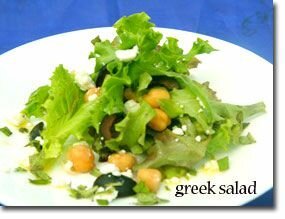healthy food tip and recipe
Today's Recipe
If you don't know what to serve for dinner tonight ...
The chopped mint adds an unusual twist to this easy-to-prepare salad that is great for lunch.

Ingredients:
- 4 cups salad greens
- 2 TBS chopped mint
- 3 TBS crumbled feta cheese
- 2 TBS chopped olives
- 1/2 cup garbanzo beans
- 1 TBS extra virgin olive oil
- 1 TBS red wine vinegar
- sea salt and pepper to taste
- Combine first five ingredients.
- Toss with olive oil and vinegar, and add salt and pepper to taste.
In-Depth Nutritional Profile for Greek Salad
Healthy Food Tip
What is phytic acid and can it interfere with the absorption of iron from plant-based foods?
Phytic acid is a unique substance that serves as one of the primary storage forms for phosphorus in plants. It is composed of inositol-a B vitamin-like molecule-and six phosphorus-containing units. As part of the natural composition of plants, phytic acid is likely to have health benefits, even though research studies on these health benefits are still in the early stages. Phytic acid appears to have important antioxidant properties in certain circumstances when cells and tissue need protection from oxidation, and it also appears to have important anti-inflammatory properties.
Phytic acid is also one of the substances found in some plant foods that can bind together with non-heme iron and lower its absorption. While there is no question that phytic acid lowers absorption of non-heme iron, the degree to which absorption is lowered, and the practical consequences of this lowering, is a matter of some debate. Since we never absorb more than approximately 20% of the iron found in plants-even when those plants contain no phytic acid whatsoever-we would always be getting relatively small amounts of bioavailable iron from any single food within a plant-based diet.
Luckily, however, a very large number of plant foods can provide us with a small amount iron. About 50 of the World's Healthiest plant foods rank as "good," "very good," or "excellent" sources of iron! When all of these plant foods are combined together in a balanced diet, they typically end up providing a healthy supply of iron. In a single serving, any one of these foods will provide less than 10 milligrams of total iron, and therefore at most, only 2 milligrams of bioavailable iron. But remember that it's the combination of all foods that is important.
For all of the above reasons, I am not overly concerned about the impact of phytic acid on iron availability, even though it clearly lowers iron availability. I am not overly concerned because I do not think it makes sense to get sidetracked on any single food when it comes to our iron needs and how they can be met from a plant-based diet. In a plant-based diet like the Healthiest Way of Eating, what makes sense to me is to plan an overall diet that contains plenty of iron-containing foods, even when those foods also contain phytic acid. In other words, I think about iron as a mineral that we must count on our diet as a whole to provide. While the phytic acid levels in a food like one cup of quick-boiled spinach will definitely lower the absorption rate of its 6.5 milligrams of total iron (perhaps by 1 milligram), I believe that our lesser absorption of iron from this spinach is healthy and natural, provided that we balance our overall daily intake and make sure that this spinach is one of many iron sources.

No comments:
Post a Comment